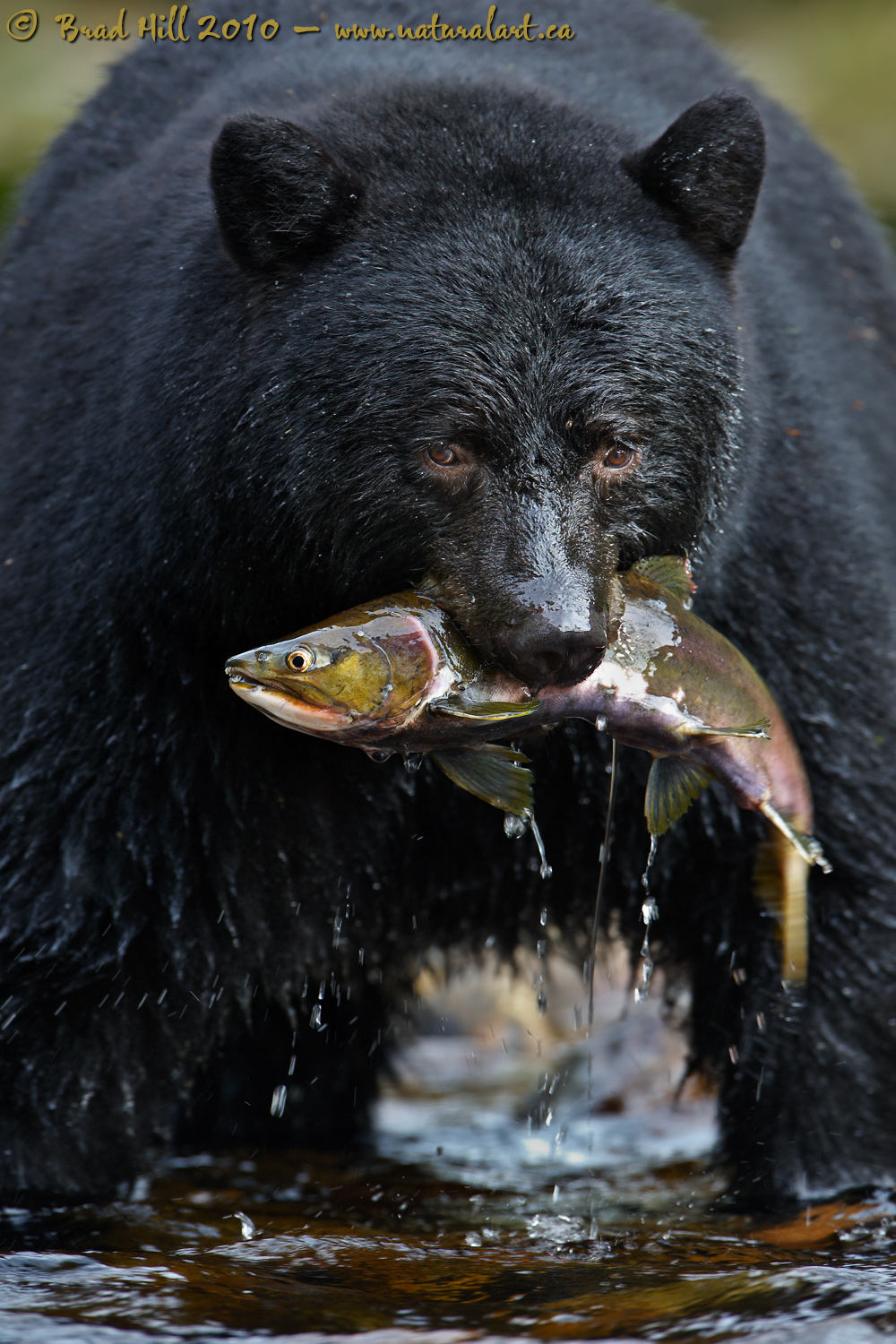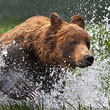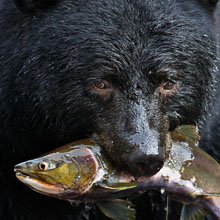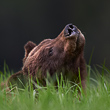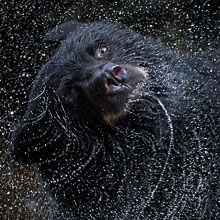Availability: Undetermined - Enquiries?
In the Field
A Furry Forest Fertilizer! Great Bear Rainforest (northern BC coast), BC, Canada. Sept 28, 2009.
This was a bit of a tough shot to capture. On average, I find Black Bears trickier to photograph than Brown (or "Grizzly") Bears, largely because it can be very challenging to get the exposure right and ensuring that the subtle black-on-black detail is retained. Commonly when photographing Black Bears it's best to slightly over-expose the image (relative to what your light meter is telling you) to capture the full tonal range of their "black-on-black" coats. But in this shot getting the right exposure was even tougher - the reflected highlights on the "wet bits" (including the bear's snout, the salmon, and the water below the bear and between its legs) really complicated things. Any over-exposure of this scene would have lead to a major blowout of highlight details that could not have been retrieved. To "solve" the problem of potentially blown highlights I did two things: I used a circular polarizing filter to cut some of the glare of the reflections and I exposed to just retain highlight detail (which, in this case, meant a slight UNDER-exposure, despite the darkness of the subject). The resulting raw file appeared to have BOTH blown highlight detail and lost shadow detail (this scene had a huge brightness/dynamic range). But, when I looked at my histogram I was quite confident I had enough "headroom" in the file to retrieve both the highlights and the shadows. This is definitely an example of where my processing experience with files specific to my D700 influenced how I chose to capture the image (i.e., I had to know how much shadow detail AND highlight detail I could actually retrieve from a D700 file without introducing noise). I daresay this is an image that could NOT have been effectively captured as a JPEG file (with current technology).
Besides being a great example of a "shoot-to-process" capture, I like this image both as a photographer and as a biologist. As a photographer I like the image on two levels. First is simply the drama and action (and the fact that both the eyes of the bear and the eye of the salmon are in focus!). Plus, from a compositional perspective there's a subtle repeating pattern that appeals to my eye (and is what caught my eye when I was culling the images and saved it from the trash bin). I'm referring to the repeating pattern of curves and arches, including the arching "tunnel" between the bear's legs,the curve of the fish, the curve at the top of the bear's head, the arch of the bear's forelegs, and, finally, through to the arch of the backside of the bear.
As a biologist I like the image because it nicely illustrates the role of bears (both black and brown) as keystone species in coastal regions. Keystone species are those which play an ecological role that is disproportionate to their numbers (or biomass) in the ecosystem. In other words, they have a disproportionately large role in influencing the composition of the other species in the ecosystem. While this bear is obviously having an impact on the future of THIS fish, what isn't shown here is what happened AFTER the image was shot and how it impacts on the "big picture" (i.e., the ecosystem). And that event was the bear disappearing far into the forest and munching on the fish. This act - taking the fish off into the forest and leaving its carcass there - plays a huge role in getting nitrogen FROM the fish INTO those massive trees of the Great Bear Rainforest. Studies (tracing the isotopes of nitrogen found in salmon) have shown that a major source of nitrogen in the trees come from the salmon - with the bear unwittingly acting as the diligent forest fertilizer! Take the bears away and the trees lose their furry fertilizing agents and the forest changes in structure. Cool, eh?
And you thought this was just a picture of some old bear!
Here's a larger (2400 pixel) version of this very rotund black bear
• A Furry Forest Fertilizer: Download 2400 pixel image (JPEG: 1.5 MB)
ADDITIONAL NOTES:
1. This image - in all resolutions - is protected by copyright. I'm fine with personal uses of them (including use as desktop backgrounds or screensavers on your own computer), but unauthorized commercial use of the image is prohibited by law. Thanks in advance for respecting my copyright!
2. This image was captured during one of my autumn "Into the Great Bear Rainforest" photo tours in 2009. Each year I offer trips into two different parts of the Great Bear Rainforest as well as one to photograph marine mammals and oceanscapes near the northern tip of Vancouver Island. And, in selected years, I also offer photo tours to additional locations to capture other highly sought-after subjects, such as various boreal owl species, fishing grizzlies, and more. Details about these trips can be found on the Photo Tours page of this website.
3. Like all wildlife photographs on this website, this image was captured following the strict ethical guidelines described in The Wildlife FIRST! Principles of Photographer Conduct. I encourage all wildlife photographers to always put the welfare of their subjects above the value of their photographs.
Behind the Camera
A Furry Forest Fertilizer! Great Bear Rainforest (northern BC coast), BC, Canada. Sept 28, 2009.
Digital Capture; RAW 14-bit format; ISO 720.
Nikon D700 with Nikkor 600mm f4 VR lens - handheld. VR on and set to "Normal" mode. Circular polarizing filter used.
1/160s @ f5; -0.33 stop compensation from matrix-metered exposure setting of camera.
At the Computer
A Furry Forest Fertilizer! Great Bear Rainforest (northern BC coast), BC, Canada. Sept 28, 2009.
RAW Conversion to 16-bit TIFF, including first-pass/capture sharpening using Phase One's Capture One Pro 5. Four RAW conversions at different exposure settings. Exposure settings varying from -2.0 stops compensation (to retrieve highlight detail in wet surface of fish and bear's nose) through to +.67 stops to retrieve shadow detail on the bear.
Further digital corrections on 16-bit TIFF file using Adobe's Photoshop CS5 and Light Craft's LightZone. Photoshop adjustments included compositing and masking of 4 exposure versions, selective saturation and desaturation of colours and selective sharpening for web output. Final tonemapping and tweaking performed with LightZone use the (tonemapper/re-light tool).
Conservation
A Furry Forest Fertilizer! Great Bear Rainforest (northern BC coast), BC, Canada. Sept 28, 2009.
Ten percent of the revenue generated by this image will be donated to Raincoast*.
Species Status in Canada**: Not currently listed as Threatened or Endangered.
This black bear is a member of the subspecies "Kermodei" (Ursus americana kermodei). This subspecies is unique in that the population is characterized by having an unusually high proportion of a recessive gene that produces white coat colour (found on the "Spirit Bears"). Because the Black Bear is not considered under threat as a species, both the Kermodei subspecies and the very rare Spirit Bear suffer from having the same conservation designation (it should be acknowledged that in British Columbia - the jurisdiction of greatest Spirit Bear abundance - hunting of these white-coated bears is not permitted). For reasons that are not fully understood, the Spirit Bear occurs with greater frequency in a relatively small geographic area within The Great Bear Rainforest of the central and northern coast of British Columbia. In this area 10 to 30% of the bears possess white coats. Many of the black-coloured Black Bears in this region carry the gene for white coats, so allowing hunting of ANY Black Bears in this region can reduce the frequency of the gene for white coats. Thus, to protect the Spirit Bear, it is necessary to prohibit the hunting of ALL Black Bears in this region. And, very unfortunately, the globally unique ecosystem that contains the Spirit Bear is under development pressure, especially from the forestry industry. If this unique environment is altered, we may lose the wonderful genetic anomaly known as the Spirit Bear forever.
*The Raincoast Conservation Society (and Foundation) is an effective and efficient organization that has been fighting for protection of this unique habitat. If you are looking for a meaningful way to contribute to the conservation of this amazing ecosystem, Raincoast will provide maximal "bang" for your conservation dollars.
**as determined by COSEWIC: The Committee on the Status of Endangered Wildlife in Canada












